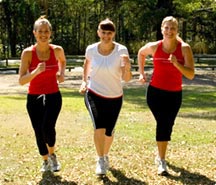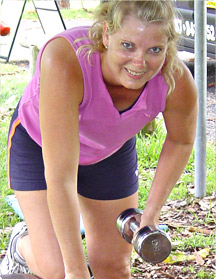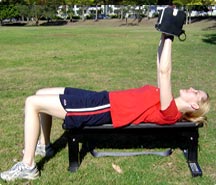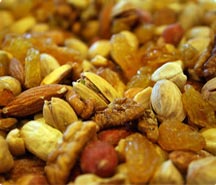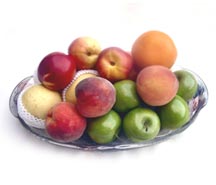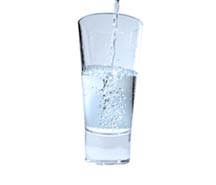Fitness & weight loss Brisbane
Cardio Fitness
Why I should exercise?
Heart disease is the largest cause of death of adult Australians. If you are over 40 years of age, the risk of having coronary heart disease at some time in the future is one in two for men and one in three for women. And these risks increase with age. Much of heart disease however, is largely preventable.
As we age, the pumping capacity of the heart decreases, causing an increase in the resting heart rate. The body's ability to process oxygen efficiently decreases by one to two percent each year after the age of 40.
Research has shown that regular physical exercise can slow down that process and therefore significantly reduce the risk of heart disease as well as lower cholesterol levels, increase lung capacity, improve stamina, decrease cholesterol levels and provide stress reduction and body fat burning.
How much exercise do I need?
This depends on a number of factors, such as age, current level of fitness and general state of health, but generally activity should be intense enough to significantly increase blood flow to the muscles for an extended period of time.
If you’re not a regular exerciser take care not to do too much too soon. Begin exercising slowly and gradually increase the intensity levels of your workouts as you get fitter. Regular cardio exercise of 30-45 minutes a day, five times a week should be sufficient for most people to significantly increase their fitness. If fat burning is your main goal, increase the duration of your workout rather than increasing speed of movement.
What are some cardio exercises I can do?
It is important to choose exercises that you enjoy doing and to try different types of exercises often, so that you won’t get bored doing the same things. Non regular exercisers should begin with low impact exercises such as brisk walking, swimming, core stability exercises and stretching. Examples of more intensive cardio exercises include cycling, rowing, jogging, skipping, running and boxing. If you can, exercise in a group or with a friend because training with others will help keep you more motivated.
To avoid the potential risk soft tissue injury begin your workout with a 5-10 minute warm-up of low-medium intensive activity and be sure to end your session with a 5-10 minute cool-down period and stretching. If you also strength train do your cardio exercises after weights, not before.
Incidental exercise
Contemporary lifestyle has had a huge impact on our physical well-being. Modern technology and greater affluence have reduced the opportunity that we once had of burning energy through every-day activities. Because of this it is important that we look for ways to participate in what is known as incidental exercise. Walking the stairs and escalator, parking the car at the end of the parking lot and washing the car by hand are all examples of incidental exercise.
Footwear & clothing
Wearing correct footwear and clothing when exercising will reduce the potential risk of injury and overheating. Large sport’s shoe retailers such as The Athlete’s Foot & AMart All Sports should be able to advise the best type of footwear most suitable for you. Clothing ought to be comfortable and loose fitting.
Should I obtain a medical clearance before exercising?
If you are over 45 years of age, very overweight, have not exercised for some considerable time, or you or members of your family have a history of heart disease you should consult your doctor before exercising.
Accept the challenge today
For most people regular exercise is a challenge and may require a change in lifestyle. Commit yourself today to exercise regularly. The potential health benefits and results, as well as the satisfaction you’ll experience will make the commitment well worth the effort.
Back to top
Toning & Strength
Strength training as well as cardio training is important in maintaining a fit and healthy body and you don’t need to spend hours in a gym to obtain good results. For most people, lifting weights 20-30 minutes, 2-3 times a week is sufficient to receive significant toning and strength benefits. Regular toning/strength training will not only have you looking and feeling great, but according to scientific research, you’ll also receive many other significant health benefits.
Increased or replaced muscle tissue
Adults who do not strength train lose approximately 2.2kg to 3.2kg of muscle every decade. Although cardiovascular exercise improves our fitness it does not prevent the loss of muscle issue. Strength exercises not only maintain our muscle mass and strength throughout our lives, but can also significantly increase muscle mass over a relatively short period of time.
Decreased body fat
More muscle means more fat burning. If you want to burn fat faster and have a lean, toned body you need to do strength exercises.
Decreased blood pressure
Research has shown that strength training can significantly reduce the risk of high blood pressure and coronary heart disease. Doing both strength and cardio exercises is an even more effective means of preventing high blood pressure.
Decreased risk of Diabetes
Because strength training increases lean muscle mass the uptake of blood sugars into the muscle cells is increased. This can result in a reduction in the incidence of diabetes. The metabolic rate is also increased by strength training, which aids in the reduction of fat. Type 11 diabetes is directly related to fat.
Increased metabolic rate
As we age, our metabolic rate slows down by as much 2%-5% every decade because we lose muscle tissue. Every kilogram of muscle that we can maintain, or put on, will burn as much as an extra 100-200 calories per day causing an increase our metabolic rate.
Increased functional strength
It is the co-ordinated recruitment of muscle fibres that is responsible for the performance of functional everyday activities including walking, lifting and sitting. If the muscles of the body are progressively overloaded in a functional manner they will be stronger and therefore be more capable of performing everyday activities with less effort.
One in three women and one in eight men suffer from osteoporosis, a disease causing bone degeneration and breakage. Strength training has been shown to slow down bone degeneration and increase bone mineral density.
Increased joint stability and strength
It is the muscles of the body that hold and stabilise the bones and joints of the skeleton. Therefore joint strength and stability are dependent upon the ability of the muscles to control the two adjoining bones in their correct position during normal posture and movement. If the muscles are strengthened in a functional manner, than the stability of joints will be greatly enhanced, resulting in improved posture and less chance of injury and arthritis.
Decreased risk of injury
Strength training will make muscles stronger and increase their ability to support and protect the body as well as enhance the body following injury. Strength training plays a vital role in the functional rehabilitation process by rehabilitation therapists.
Back to top
Body Fat
Unfortunately, in striving for the “ideal” body most people become far too concerned with how many kilograms they weigh. Our body measurements, particularly the waist and hips are a far better indicator of what a healthy body shape should be.
Recent research indicates that the “bigger the waist the bigger the risk” to our health. Waist measurement is a good predictor of the risk of heart disease. A waist circumference of more than 80 centimeters in women and more than 85 centimeters in men increases the risk of heart attack. Other indicators of a healthy body shape can be determined by calculating your Body Fat Percentage, Waist to Hip Ratio and Body Mass Index (BMI).
Body fat percentage
Body fat calipers are an accurate method to measure body fat percentage however, unless you know how to use them correctly the results may not be exact. Some scales provide body fat percentage readings and although not as accurate as calipers they will give you a reasonable estimate.
Waist to hip ratio
Waist to hip ratio provides a measurement of the distribution of body fat. It is determined by dividing waist circumference by hip circumference. A high waist to hip ratio, which represents excess body fat is one of many risk factors for heart disease. People with a high waist to hip ratio are at greater risk than people who store fat around the butt area and are pear shaped.
Body mass index (BMI)
Body mass index is a basic measure of body composition. However, its accuracy is questionable because it relies on scale weight to measure body composition which does not allow you to distinguish fat weight from lean weight. People who have a high proportion of muscularity record high results on their BMI.
Body Fat Percentage
Age |
Lean |
Acceptable |
Moderately Obese |
Obese |
Males |
|
|
|
|
Females |
|
|
|
|
Waist to Hip Ratio
Waist to Hip Ratio (WHR) = Waist (cm) divided by Hips (cm)
| Measurement | Low |
Below Average |
Average |
Above Average | High |
Male |
<0.85 |
0.85 - 0.89 |
0.9 - 0.94 |
0.95 - 0.99 |
>0.99 |
Body Mass Index (BMI)
BMI = Weight (kg) divided by Height (m) squared (kg/m2)
Males – Scores |
Females – Scores |
Rating |
Under 20 |
Under 18 |
Underweight |
20-25 |
18-23 |
Healthy range |
26-30 |
24-28 |
Overweight |
Over 30 |
Over 28 |
Obese |
Nutrition
Overview
Eating healthy and nutritious food, together with regular exercise is the key for most people to lose or maintain their correct weight. The average body has approximately 2,000 calories of readily available energy that mostly comes from food and drink consumed during the day. If we consume more calories during a particular day and don’t burn up the excess through activity then that excess will be stored in our bodies as fat. If we multiply the daily excess by 365 we can see how easy it is to put on weight over a 12 month period.
Every kilogram of stored fat that we have in our bodies represents approximately 7,500 calories. Therefore if we are 10 kilograms overweight we have 75,000 excess calories of stored fat in our bodies. The safest and most effective way to burn excess fat and lose kilograms is a combination of healthy eating and exercise.
Do not diet
Most diets are based on calorie restriction and deprivation. In such diets there will be an initial weight loss, due mostly to loss of water and muscle tissue. Losing muscle tissue results in a slower metabolism that will most likely result in regaining the weight lost plus interest once normal eating habits resume. The key to healthy nutrition is to eat a well balanced diet and eat everything in moderation.
2/3rds - 1/3rd principal
2/3rds of what we eat should come from out of the ground. Lots of variety, colour & texture is best. Aim to eat at least 2-3 pieces of fruit and 2-3 cups of vegetables every day as they will provide most of your daily vitamin and mineral requirements. The other 1/3rd can come from animal products, processed foods and other foods.
The pyramid plan
Eat small amounts - sugar, saturated fats, processed foods, white flour, bread and pasta.
Eat some - fish, lean meats, lean chicken, low fat milk, low fat cheeses, eggs.
Eat most - fruit, vegetables, wholegrain cereal and wholegrain bread, brown pasta, brown rice and legumes.
Drink water
Water is the most important substance that we take into our bodies. Water aids in the digestion of fibre and in cardiovascular, muscular, neural and brain functions. Aim to drink 6-8 glasses of water daily + one extra litre for every hour of exercise. If you don’t like the taste of water add a little lemon or lime juice.
Eat good fats
We all need some fat in our diet. Fats help nutrient absorption, nerve transmission, maintaining cell membrane integrity etc. However all fats are not created equal. Mono-unsaturated fats (eg. raw nuts, avocado and olive oil) and poly-unsaturated (eg. seafood and safflower) promote our health positively. Saturated fats, particularly Trans fats (eg. commercially fried foods) contribute to weight gain and an increase in the risk of heart disease and certain types of cancer. The key is to replace bad fats with good fats in our diet.
Eat low glycaemic carbohydrates
Low glycaemic carbohydrates (eg. brown pasta, most fruit & vegetables) are slowly digested into the blood stream causing feelings of satisfaction whereas high glycaemic carbohydrates (eg. foods with a high sugar content) are more quickly absorbed into the blood stream and often result in hunger.
Eat smaller and more regular meals
Eat 5-6 smaller meals a day instead of the usual 3 large meals. This will result in a faster metabolism and should help control “binge” eating.
Eat fibre
Eat foods with a high fibre content such as whole grains, bran cereal, oatmeal, apples, vegetables and unrefined grain foods. Consuming high fibre foods can keep you regular, control blood sugar levels, lower cholesterol and heart disease, improve digestion and reduce the risk of bowel and colon cancer.
Eat protein
Protein is required by the body to build muscles, repair cells and prevent blood clotting. Sources of protein include cheese, meat, chicken, fish, eggs, milk.




